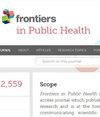城市建筑环境中的高血压风险路径:以中国蚌埠市禹会区为例
IF 3
3区 医学
Q2 PUBLIC, ENVIRONMENTAL & OCCUPATIONAL HEALTH
引用次数: 0
摘要
引言 城市化的快速发展带来了居民生活环境和行为方式的改变,引发了高血压等健康问题。改善社区建筑环境有助于建设健康城市,促进居民积极生活,预防和缓解高血压。然而,关于社区建筑环境与高血压之间关系的研究却很少。本横断面研究旨在评价蚌埠市禹会区社区建筑环境、居民健康行为与高血压等级之间的关系。结果与讨论结果显示,城市社区建筑环境对居民高血压有显著影响。超市、便利店、公园和广场密度高,而诊所和医院密度低,被认为是居民患高血压的重要风险因素。然而,养成健康的行为习惯,包括定期步行、体育锻炼和多吃水果蔬菜,对降低高血压风险有重要作用。这项研究结果表明,改善城市社区的建筑环境有助于降低居民的高血压患病率。此外,在城市环境中实施有效的健康干预措施将有助于改变居民的健康行为,提高他们的整体健康水平。本文章由计算机程序翻译,如有差异,请以英文原文为准。
Hypertension risk pathways in urban built environment: the case of Yuhui District, Bengbu City, China
IntroductionThe rapid development of urbanization has brought about changes in residents’ living environment and behavior, leading to health challenges such as hypertension. An improvement in the built-up environment in the community could contribute to the construction of a healthy city, promote the active life of the residents, and prevent and relieve hypertension. However, there is little research on the relationship between the built environment of the community and hypertension. This cross-sectional study aims to evaluate the relationship between communities’ built environment, health behavior, and hypertension grade of residents in Yuhui District of Bengbu City.MethodsThis study is based on data from the 2022 Health Survey of Residents in 21 communities. To investigate the impact of the community’s built environment on residents’ hypertension and the underlying mechanisms, regression and structural equation modeling were employed.Results and discussionThe results show that the built environment of urban communities has a significant impact on the residents’ hypertension. The presence of high densities of supermarkets, convenience stores, parks and plazas, but low densities of clinics and hospitals, has been identified as a significant risk factor for the development of high blood pressure among the residents. Nevertheless, the adoption of healthy behaviors, including regular walking, physical activity, and a diet rich in fruit and vegetables, can play an important role in reducing the risk of hypertension. The findings of this study show that enhancements to the built environment in urban neighborhoods could contribute to a reduction in the prevalence of hypertension among residents. Furthermore, the implementation of efficacious health interventions in urban settings would facilitate the alteration of residents’ health behaviors and enhance their overall health status.
求助全文
通过发布文献求助,成功后即可免费获取论文全文。
去求助
来源期刊

Frontiers in Public Health
Medicine-Public Health, Environmental and Occupational Health
CiteScore
4.80
自引率
7.70%
发文量
4469
审稿时长
14 weeks
期刊介绍:
Frontiers in Public Health is a multidisciplinary open-access journal which publishes rigorously peer-reviewed research and is at the forefront of disseminating and communicating scientific knowledge and impactful discoveries to researchers, academics, clinicians, policy makers and the public worldwide. The journal aims at overcoming current fragmentation in research and publication, promoting consistency in pursuing relevant scientific themes, and supporting finding dissemination and translation into practice.
Frontiers in Public Health is organized into Specialty Sections that cover different areas of research in the field. Please refer to the author guidelines for details on article types and the submission process.
 求助内容:
求助内容: 应助结果提醒方式:
应助结果提醒方式:


